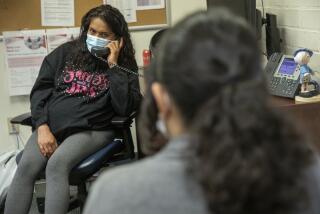Visa Cut Threatens Rural Clinics
WATERFORD, Calif. — This little town is lucky. When Dr. K. Krishnamoorthi arrived last year, he became the first full-time doctor in a decade at its worn brick clinic. Now, walk-ins are welcome. Krishnamoorthi gamely explains every ailment from toenail fungus to heart disease in his South Indian lilt, and even telephones patients at night to check on their progress.
“What I’m happy about is just feeling good about the doctors here and not having to go to Modesto,” said Carol Harrison, 53, who raises Holstein cows nearby and was recently treated for a throat infection and, yes, toenail fungus. A convenience for her, the shorter medical trips are a significant comfort to her mother-in-law, who is under Krishnamoorthi’s follow-up care for heart surgery and a collapsed lung.
For many agricultural workers with no access to transportation, the proximity of a physician is a vital necessity.
The baby-faced Krishnamoorthi is part of a federal program that has addressed a critical shortage of medical care across rural America. Thanks to visa waivers sponsored by the U.S. Department of Agriculture, more than 3,000 foreign doctors have been assigned since 1994 to small towns.
But the program that brought Krishnamoorthi to this Central Valley farm town has fallen victim to the war on terrorism. Citing post-Sept. 11 security jitters, the department announced earlier this year that it would no longer sponsor the visa waivers.
The decision has caused panic among rural health advocates, who have come to depend on foreign medical graduates to hold together the country’s fragile rural health system. In some areas, the foreigners make up more than 40% of all doctors. In California, the program has supplied towns with 232 doctors.
“If a federal agency is looking for a way to generate any greater vulnerability in an already under-resourced rural health system, this is a great way to do it,” said Nancy Oliva, a public health consultant and board member for the Oak Valley Hospital District, which includes Waterford. “We rely on an international manpower pool.”
Krishnamoorthi works in Waterford because a two-year search by the clinic’s owner yielded not a single American-trained doctor. Six of the last eight doctors recruited to Waterford and the surrounding towns of Oakdale, Riverbank and Escalon have been foreign medical graduates granted special visa waivers. Among them were a pediatrician from Peru, doctors from the Philippines, one doctor from Syria and another from Iraq.
So-called J-1 visas require doctors to return to their home countries after they have completed their residencies, but thousands have received waivers allowing them to stay if they hang their shingles in underserved areas for three years. U.S. graduates tend to shun small towns because of long hours, antiquated hospital technology and a dearth of cultural activities.
But doctors from poorer, more unstable parts of the world have a different take on rural America. It is, after all, America. And the stints in the country significantly increase their chances of permanent residency here.
To Krishnamoorthi, 35, the Central Valley’s hot weather and seasonal harvests are reminiscent of Mangalore, the southern coastal town of fruits and flowers where he grew up. He and his wife, Soma, who is a doctor at a sister clinic in the nearby town of Escalon, are eager to stay. Three-year-old Mahima--born in the Bronx while the Krishnamoorthis completed medical residencies at Lincoln Hospital--plays in a rambling park across the street from the family’s ample Modesto home. Another baby is on the way.
“It’s beneficial for everyone,” said Krishnamoorthi. “I can have the American Dream. At the same time, I can serve a small community. We are thankful for life.”
A Bush administration task force is reviewing the program in response to an outcry from rural health advocates. The USDA decision has set off a discussion on how to balance national security concerns with the needs of rural Americans who are typically poorer, older and sicker than the population as a whole.
“For certain rural communities, the only physician available for hundreds of miles will be a J-1 visa waiver doctor,” said Alan Morgan, vice president of governmental affairs for the National Rural Health Assn., which is lobbying for the U.S. Department of Health and Human Services to take over sponsorship of the waivers or, barring that, for the USDA to reconsider. “It’s had a tremendous impact.”
Any federal agency can sponsor an unlimited number of the waivers, but since 1994 the USDA had taken the lead, accommodating doctors mostly from India, Pakistan, the Philippines and the Middle East.
A separate waiver program, sponsored by the states, has brought 2,000 additional doctors into underserved rural and urban areas since 1998. But, coincidentally, that program expired on June 1 and must be reauthorized by Congress. Pending bills that would extend and expand the states’ program have bipartisan support and are expected to pass.
California began participating in that program only this year, days before the USDA slammed its doors. The Department of Health Services was inundated with applications and filled its 20-doctor quota quickly. Most of the doctors are headed for rural towns, including the Central Valley’s Los Banos and Dos Palos. But Health Services will also be sending doctors to several urban clinics--not allowed under USDA guidelines--and providing desperately needed psychiatrists to the counties of Fresno, Merced and Tulare.
There are many more remote places than Waterford (population 6,924), which is just 15 miles from the relative bustle of Modesto. But the two-lane road to Modesto can make for an agonizing journey for the sick.
Waterford recruited Krishnamoorthi before the USDA decision, so its clinic will be fully staffed for two more years and possibly longer, if the Krishnamoorthis settle here permanently.
Nearby Oakdale wasn’t so lucky.
The town’s sole pediatrician, Polish-born Dr. Krystyna Belski, lost her Peruvian partner, a J-1 visa waiver doctor, earlier this year to Modesto when his medical group pulled out for business reasons.
Belski was on the verge of hiring a Salvadoran-born specialist in pediatric infectious diseases on a J-1 visa, when the USDA pulled out of the program. She now rattles around in the large private clinic that she leases, on call seven days a week. Many of her Spanish-speaking patients have stopped coming, driving instead to Modesto or making do with a physician’s assistant at a public clinic. On a recent Friday, one patient with a vomiting toddler brought in her 8-year-old son to translate. But Belski must often resort to AT&T; phone translators, costly for her and cumbersome for patients.
The original intent of the J-1 visas was to provide residency training to foreign medical graduates, then send them back to serve their underdeveloped home countries. But as a physician shortage flared in the 1970s, more J-1 recipients received permission to stay, said Thomas R. Konrad, who directs the program on health professions and primary care at the University of North Carolina’s Sheps Center for Health Services Research.
But the program has been dogged by political tensions. Organizations representing U.S. medical graduates have strongly objected whenever there appeared to be more than enough U.S.-trained doctors.
The Department of Health and Human Services decided to sponsor the waivers only for researchers. But rural areas were going without service and, in 1994, the USDA stepped in. The states followed suit four years later.
Whether there is a nationwide glut or shortage of doctors remains a topic of hot debate in academic and policy circles. But shortages in rural areas have persisted for decades. Even with financial incentives, it’s difficult to attract U.S. medical graduates to such areas.
The new reality of stricter visa policies now has health experts looking harder at domestic alternatives. The Bush administration has proposed increasing the National Health Service Corps. budget from $99 million to $143 million next year. That program pays off loans and provides scholarships to U.S.-trained doctors who serve in shortage areas, but has fluctuated along with federal budgets.
A recent report by the Rural Policy Research Center suggested expanding programs to attract rural youths to the medical profession. The report also proposes stricter security measures, in hopes of saving the visa waiver program.
“In the near term, it’s an absolutely vital role that international medical graduates play,” said Keith J. Mueller, the report’s main author. “The future could be different.”
Here in Waterford, Krishnamoorthi has been welcomed--although at times clumsily. Patients had so much trouble with his last name that he shortened it to Moorthi on the clinic sign. He tolerates his truncated identity, and the mispronunciations, with good humor.
He and his wife have adapted easily, but they are not pioneers. Photographs of other foreign medical graduates fill the pages of the county’s medical society directory. Among them is Indian-born Dr. Brij Gupta, the Krishnamoorthis’ boss.
The Krishnamoorthis live one block from Gupta, rounding out a small community of more than half a dozen Indian-born doctors in the region. Modesto offers two Indian supermarkets and two Punjabi restaurants.
Rural doctoring suits the Krishnamoorthis. They are honing the Spanish they learned during their residencies in the Bronx. And there is a warmth here that they did not always experience in New York, where they treated hostile patients suffering from addiction or mental illness.
“The patients know that I’m expecting a baby and that my husband’s a doctor, and they ask about me,” said Soma, 32. “That’s the difference between here and a big city. We want to settle down here.”
More to Read
Sign up for Essential California
The most important California stories and recommendations in your inbox every morning.
You may occasionally receive promotional content from the Los Angeles Times.











